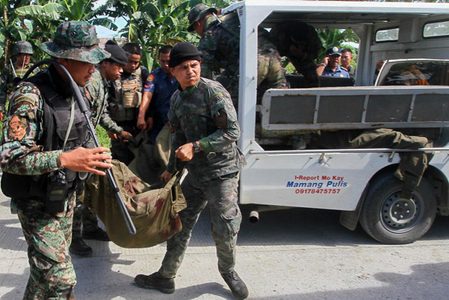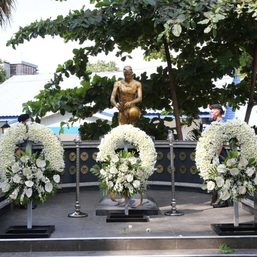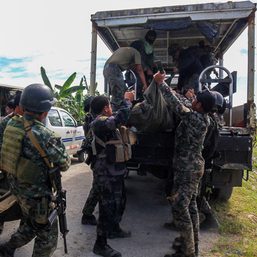SUMMARY
This is AI generated summarization, which may have errors. For context, always refer to the full article.
![[OPINION] On the movie ‘Mamapasano: Now It Can Be Told’ and the recent bombing in Marawi](https://www.rappler.com/tachyon/2023/12/tl-mamasapano.jpg)
There are a lot of questions posed in my mind when I watched this newly-featured film on Netflix. It was about the 44 Special Action Force (SAF) commandos who died on their mission during the tragic Mamasapano clash of 2015. The film was shown in last year’s Metro Manila Film Festival where it garnered some awards, including the second best picture.
After watching it, I was bothered by the introduction to the film that underscored the bounties of millions of dollars offered by the US authorities to arrest and kill the two terrorists ($5 million for the Malaysian national Marwan and $1 million for Usman). Both were under the FBI’s Most Wanted list and were hiding in the marshy area of Mamasapano, Maguindanao. It’s a well-known fact that the US, from the Pentagon to the FBI, is employing mercenaries and local military forces to undertake its anti-terrorism operations. The bounties offered are part of it.
Even if the bounties were downplayed later by a police attaché at the Philippine Embassy in Washington – he said that the local security forces are not “eligible to receive the bounty because it’s part of their job to arrest a wanted person” – there is no denying that the bounties have figured in the way the operation was conducted (the main objective of arresting and killing the two terrorists was undertaken despite the peace talks going on with the Moro rebel forces in the area). Any “operations” at the bidding of foreign authorities should not be prioritized at the expense of our police commandos and soldiers. Can’t we manage our anti-terrorist operations or deal with our rebel forces without putting ourselves within the ambit of the US war on terror?
The recent bombing at Marawi State University
The issue of the Mamasapano debacle gains traction today because of the recent bombing of a Catholic mass inside the Mindanao State University in Marawi City. Marawi was the site of a five-month battle between the AFP and the Maute terrorist group in 2017. The latest bombing is seen by some AFP officers as a response to their attack on the Dawlah Islamiyah-Philippines that killed 11 alleged terrorists on December 1. President Ferdinand Marcos Jr. immediately blamed foreign terrorists as the perpetrator. Later, in a telegram, the Islamic State (IS) group claimed responsibility for the attack.
It is commendable that the Mindanao State University officials and other Moro groups are calling for peace, not an escalated war, in resolving the Mindanao conflict. While calling on the Philippine authorities to fully investigate the bombings and arrest the perpetrators, the tri-people groups in Mindanao – from the Moros, Lumads, and Christians – are calling for an end to any religious strife and divisions. It shows how important that the Mindanao people are chiefly involved in resolving the conflict.
Long-delayed implementation of the Bangsamoro Organic Law
The bombings and other terrorist activities in Mindanao have been happening within the backdrop of the long-delayed election for the Bangsamoro Parliament, stipulated under the Bangsamoro Organic Law or RA No. 11054. The election, originally set in 2022, is now set in 2025. In the meantime, the Bangsamoro Transition Authority is set up. But the absence of a fully-functioning Bangsamoro Parliament weakens the capacity of the Moro forces themselves (not only the MILF, but the MNLF and other Moro groups, including the indigenous peoples) to intervene fully in the resolution of the conflict in Mindanao.
In the Mamasapano movie, the MILF leaders were consulted on how to resolve the battle between the police forces and the supposedly Moro rebels (belonging to a mix of MILF and BIFF, and probably others) engaged in battle. Later on, a ceasefire was declared by the MILF leaders although some forces of the BIFF continue to attack the embattled police commandos even late afternoon of that day.
The question is: isn’t it to our advantage to allow the Bangsamoro Parliament to be given authority to intervene in the conflict in Mindanao as they know all the Moro forces involved in the conflict? It was a known fact that all Moro forces had close relations with almost all rebel forces operating there. This might be a better formula than involving foreign forces, officially or unofficially (through bounty monies, for instance) in dealing with the problem in Mindanao. It will be disastrous for Mindanao, and for the entire country, to be operating mainly within the ambit of the US war on terror.
The elite’s leadership
The Mamasapano movie also highlighted the elite’s brand of leadership in a crisis. Then President Noynoy Aquino, the commander-in-chief of the Armed Forces, was responsible for hiding “Operation Exodus” from top officials of the AFP. President Noynoy Aquino also acted like an entitled brat when confronted with his weaknesses and errors in dealing with the debacle. As mentioned in the movie, he devoted his time doing a “photo shoot” in Zamboanga City despite being informed of the embattled situation of the police commandos during the raid.
What was not mentioned in the movie was that President Noynoy even ignored the arrival honors at the airport when the remains of the 44 slain police commandos were brought to Manila, deciding instead to attend the ribbon-cutting ceremony of the Mitsubishi Motors’ plant in Santa Rosa, Laguna. During a “bull session” with the PNP forces, Noynoy heaped the blame on General Getulio Napeñas, commander of the PNP Special Action Force (SAF), for miscalculating the situation and opting to stay in an area open to rebel attacks rather than retreating to a nearby coconut plantation. One of the police survivors told Noynoy Aquino that he should be mindful of his misjudgment and errors that contributed to the debacle, rather than blaming General Napeñas.
This also brings to the fore the orientation of the Philippine security forces in terms of merely obeying orders rather than adopting a democratic process of brief consultation with the rank-and-file on what’s best to do in a tight situation. This is where the Philippine security forces are weak compared to the rebel forces, not only among the Moros but even in other armed liberation forces. If there is time, consultation with the rank-and-file is important in the decision-making of the top officers before a general order can be issued.
I just hope that, in the end, justice would be given to the 44 SAF commandos who died, the Moro rebels who perished in that battle thinking that the peace process with the MILF had been violated, those killed in today’s bombing at a Catholic mass, and the hundreds of thousands of people in areas which are gravely affected by the war in Mindanao. Let us not complicate this disaster by merely pursuing the framework of the US’ war on terrorism all over the globe. Together with the people in Mindanao, let us craft our design for peace and the resolution of the conflict in the region. – Rappler.com
Sonny Melencio is the chairperson of the socialist party Partido Lakas ng Masa (PLM). He has written a book on his experiences during martial law entitled Full Quarter Storms, Memoirs on the Philippine Left.
Add a comment
How does this make you feel?


![[OPINION] After Marawi: Stories from ground zero](https://www.rappler.com/tachyon/2021/06/ispeak-marawi-stories-from-ground-zero-sq-1.jpg?resize=257%2C257&crop_strategy=attention)


There are no comments yet. Add your comment to start the conversation.